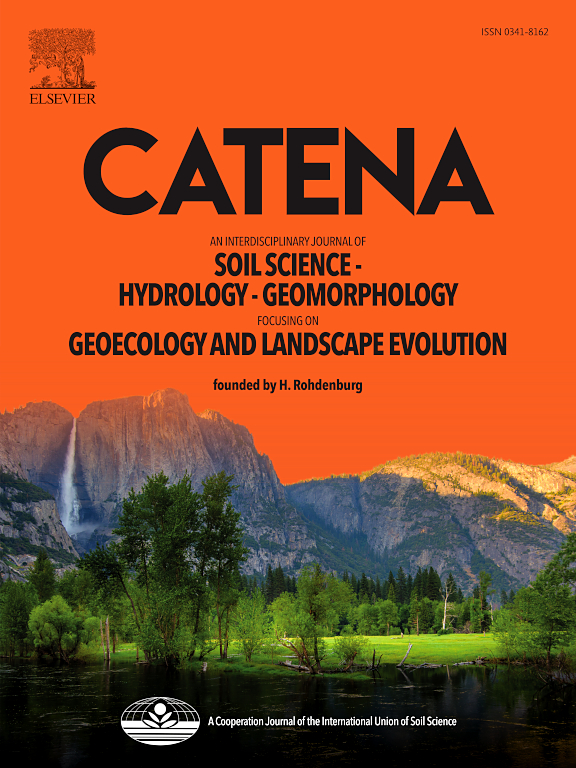Changes in soil bacterial abundance and diversity in response to drip irrigation to Establish plant communities on highly saline Lands in north China
IF 5.7
1区 农林科学
Q1 GEOSCIENCES, MULTIDISCIPLINARY
引用次数: 0
Abstract
Soil salinization represents a significant challenge to agricultural production and ecosystem establishment in arid areas. Water–salt regulation by drip irrigation has emerged as a promising approach to significantly reducing soil salinity and rapidly allowing the formation of plant communities. Although one of the most important indicators of soil quality, soil bacteria have been less extensively investigated in such studies. Therefore, the objective of this study was to investigate the effect on soil bacterial abundance and diversity of water–salt regulation by drip irrigation. To this end, the study employed a spatiotemporal iterative method through plate culture and high-throughput sequencing to examine soil bacterial changes in response to drip irrigation over a four-year period (4a), a three-year period (3a), a two-year period (2a), and a period without water–salt regulation (0a). The results demonstrated that drip irrigation significantly reduced soil salinity and increased bacterial abundance in highly saline soils. After four years of drip irrigation, the abundance of soil bacteria and actinobacteria had increased 900-fold and 1,325-fold, respectively, compared with untreated saline soils. The Actinobacteriota and Proteobacteria were the dominant bacterial phyla during testing of saline soils, and the percentage abundance of Actinobacteriota, Proteobacteria, and Chloroflexi in the topsoil increased with the increasing years of drip irrigation. The functions of the bacterial communities in response to drip irrigation changed in terms of RNA processing and modification, chromatin structure and dynamics, etc. Structural equation modeling demonstrated that the number of years of drip irrigation significantly affected soil bacterial abundance and diversity, with correlation coefficients of 95% and 43% with time, respectively. Additionally, soil bacterial abundance exhibits a more pronounced response to the duration of drip irrigation, whereas soil bacterial diversity responds more strongly to sudden shifts in soil environment. It is important to recognize that the bacterial diversity index should not be relied upon in isolation in evaluating the overall soil environment; rather, it should be combined with the abundance of soil bacteria for a comprehensive evaluation. The current study provided a scientific basis for the changes in the biological characteristics of highly saline soils in arid zones using drip irrigation and consequent water–salt regulation.
滴灌对华北高盐碱地土壤细菌丰度和多样性的影响
土壤盐渍化是干旱地区农业生产和生态系统建设面临的重大挑战。通过滴灌调节水盐已经成为一种很有前途的方法,可以显著降低土壤盐度并迅速形成植物群落。虽然土壤细菌是土壤质量最重要的指标之一,但在这类研究中对土壤细菌的研究较少。因此,本研究旨在探讨滴灌水盐调节对土壤细菌丰度和多样性的影响。为此,本研究采用平板培养和高通量测序的时空迭代方法,在4年(4a)、3年(3a)、2年(2a)和不进行水盐调节(0a)的情况下,检测滴灌对土壤细菌变化的响应。结果表明,滴灌能显著降低土壤盐分,增加高盐碱地的细菌丰度。经过四年的滴灌,土壤细菌和放线菌的丰度分别比未经处理的盐渍土壤增加了900倍和1325倍。放线菌门和变形菌门是盐渍土的优势菌门,随着滴灌年限的增加,表土中放线菌门、变形菌门和绿菌门的丰度百分比增加。细菌群落对滴灌的响应在RNA加工修饰、染色质结构和动力学等方面发生了变化。结构方程模型表明,滴灌年限显著影响土壤细菌丰度和多样性,与时间的相关系数分别为95%和43%。此外,土壤细菌丰度对滴灌时间的响应更为明显,而土壤细菌多样性对土壤环境突变的响应更为强烈。必须认识到,在评价整体土壤环境时不应孤立地依赖细菌多样性指数;相反,它应该与土壤细菌的丰度结合起来进行综合评价。本研究为滴灌对干旱区高盐土壤生物学特性的影响及其水盐调控提供了科学依据。
本文章由计算机程序翻译,如有差异,请以英文原文为准。
求助全文
约1分钟内获得全文
求助全文
来源期刊

Catena
环境科学-地球科学综合
CiteScore
10.50
自引率
9.70%
发文量
816
审稿时长
54 days
期刊介绍:
Catena publishes papers describing original field and laboratory investigations and reviews on geoecology and landscape evolution with emphasis on interdisciplinary aspects of soil science, hydrology and geomorphology. It aims to disseminate new knowledge and foster better understanding of the physical environment, of evolutionary sequences that have resulted in past and current landscapes, and of the natural processes that are likely to determine the fate of our terrestrial environment.
Papers within any one of the above topics are welcome provided they are of sufficiently wide interest and relevance.
 求助内容:
求助内容: 应助结果提醒方式:
应助结果提醒方式:


